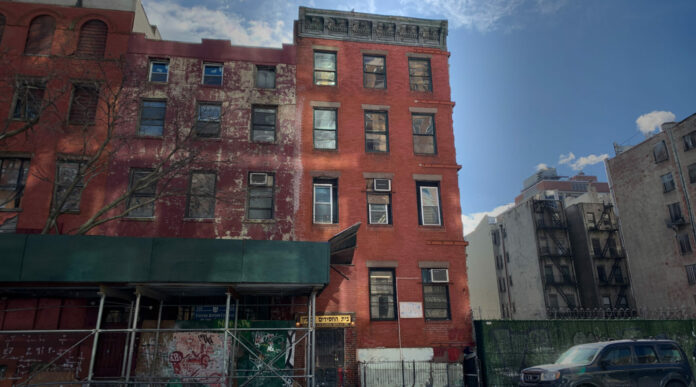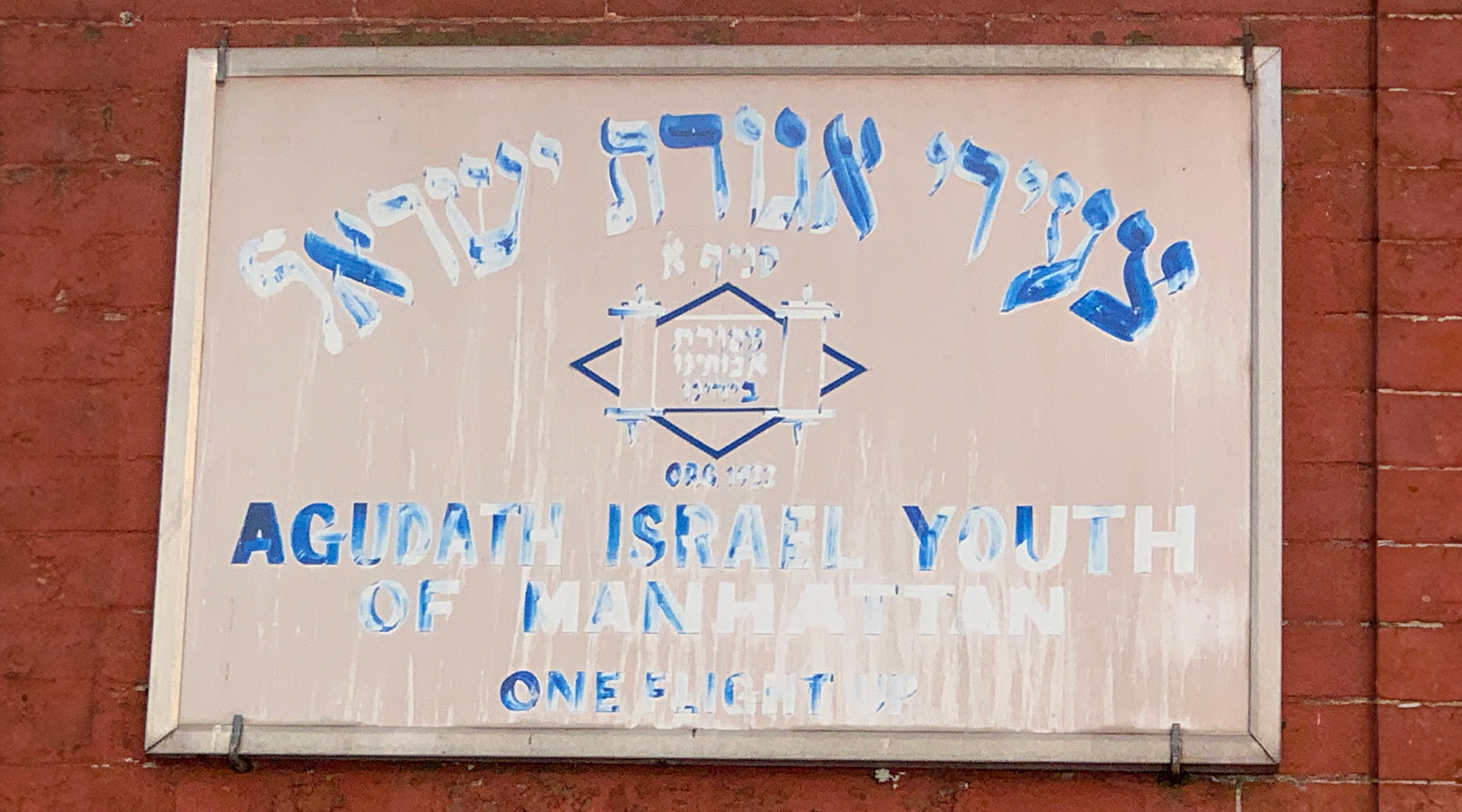
MANHATTAN (JTA) – One of the few surviving congregations on a block of the Lower East Side once known as “Shtiebel Row” is in danger of losing its minyan, the quorum of 10 men above bar mitzvah age needed to recite certain prayers.
Join our WhatsApp groupSubscribe to our Daily Roundup Email
If — or perhaps more likely, when — that happens, the small Orthodox house of worship known as Agudath Israel Youth of Manhattan will likely cease to exist, leaving just a handful of small synagogues, or shtiebels (Yiddish for “little rooms”) remaining on a stretch of East Broadway that once had more than 50.
“Once we dip below the core group we can rely on, we cease to exist, not just as an idea but as a religious fact,” the congregation’s Torah reader, Binyomin Kraus, told the New York Jewish Week.
At the moment, on a typical Saturday morning at “the Aguda,” as the shtiebel at 233 East Broadway is colloquially known, approximately 10 suit-clad men sit at a long row of tables facing the ark or at a smaller table perpendicular to it. One or two women can be found behind a cloth mechitza in the much smaller women’s section. Once the davening, or praying, has ended, the tables are covered with plastic tablecloths, and schnapps, cholent and cake are served.
In its prime, the Aguda had as many as 60 members. These days, however, Kraus isn’t hopeful that the shtiebel will survive past the summer. A young man who has been a reliable member is getting married and is expected to move out of the neighborhood — his departure, Kraus worries, will make it nearly impossible for the shtiebel to continue.
“The quorum of 10 men is all that we have and that is the critical mass,” Krauss said. “We are not a quorum when one person leaves. It’s simple.”

A faded sign announces the presence of Agudath Israel Youth of Manhattan at 233 East Broadway. At one time, there were more than 50 tiny synagogues on the block that was known as “Shtiebel Row.” (Jon Kalish)
Now in its 94th year, the congregation was incorporated in 1930 as Zeirei Agudath Israel. The shtiebel was previously located on Avenue C in what is now known as Alphabet City; it then moved to a building on East Broadway that was subsequently torn down and replaced by a church. The Aguda moved into its current location in 1968 when it leased the second-floor from the congregation that owned the four-story structure, Beth Hachasidim DePolen. A sign over the entrance to the building says “Congregation Beth Hachasidim DePolen, Inc.” and to the right of that an old, sun-bleached sign reads “Agudath Israel Youth of Manhattan, one flight up.”
These days, the Aguda is only open on Saturdays. Several of the congregants are volunteers for Hatzalah, the local volunteer ambulance service, and they leave their emergency radios on the table in front of them next to prayer books, making the crackle of radios part of the Shabbos soundtrack. When the Hatzalah guys have to run out on a call, men from the Beth Hachasidim DePolen shtiebel on the floor below come upstairs to round out the minyan.
“I’ve been davening there my whole life,” Dovie Jacob, 48, said. “My father davened there. It’s a big family.” His late father, Harold “Heshy” Jacob, founded the Lower East Side Hatzalah service, served as general manager of two Grand Street co-ops and was called “the last of the great power brokers of the Jewish Lower East Side” by the Forward when he died in June 2016.
Yossi Bistricer, 75, who works as a risk manager for a Jewish social services agency, considers himself as a “newcomer” to the shtiebel. “When I started going there in the late 1990s, it was very crowded,” he said. “You couldn’t get a seat. It was a much livelier place back in the day.”
But the sense of community remains. “We have people who are Talmudic scholars,” he said. “We have people who are community service people. The people there are very generous.”
Kraus, 60, has lived on the Lower East Side his entire life — he’s had many of his life’s most important religious milestones play out in the shtiebel, including his bar mitzvah and the aufruf ceremony before his marriage. It is where Kraus said he “learned how to learn Torah.” Kraus gave his first dvar torah, a talk on the week’s Torah portion, there and was urged to master the art of public speaking by his father, who insisted he get up and speak to the shul on the anniversaries of his grandfather’s death. His father also compelled him to become a ba’al koreh, or Torah reader.
According to Bistricer, Kraus is “an excellent baal koreh. There’s absolutely no one like him.”
“Don’t tell him I said so,” he added, jokingly. “It’ll go to his head.”
As a younger man, Kraus for many years served as a paid Torah reader for congregations outside the neighborhood — something that that angered Kraus’ father, who felt that his father, who was ordained at the famed Pressburg Yeshiva, one of the most influential yeshivas in Central Europe in the 19th century, believed it was more honorable to serve a congregation without compensation.
For a long period, due to their strained relationship, Binyomin Kraus left the shtiebel. But when his father was diagnosed with cancer, the pair reconciled. Kraus returned to the Aguda before his father passed away in 2009, and has remained there ever since.
“Every Shabbos that another minyan happens, I feel like I have honored not just my father and my uncle and my brother-in-law,” Kraus said, “I feel like I have honored all the people who came to this shul and davened here for so many years and are no longer there.”

Binyomin Kraus, 60, is the de facto leader of the congregation. His family’s connection to the shtiebel goes back 70 years. (Courtesy)
Kraus has vivid memories of the Lower East Side of yesteryear, when he couldn’t walk more than 10 steps on a Saturday morning without seeing another Jew to whom he would say, “Good Shabbos.” There were a lot of Holocaust survivors in the neighborhood, many of whom were not observant, and he recalls how Orthodox Jews who had moved to the suburbs would visit the Lower East Side on Sundays and stand in line outside Miller’s, a kosher cheese store on Essex Street.
Today he is well aware that the neighborhood’s population of observant Jews has been declining for many years, even as the Orthodox population has shown explosive growth in Brooklyn and New York suburbs like Rockland County. “What’s happening to the Orthodox Jewish Lower East Side is that it’s contracting very sharply, both through death and people leaving the neighborhood,” he said.
“Every synagogue is trying to hold on to what it has,” said Bistricer. “Every synagogue is in danger of becoming a memory.”
The exodus of Jews from the Lower East Side actually began a century ago, according to historian Bradley Shaw, who gives walking tours for the Lower East Side Jewish Conservancy and his own company, NY History Tours. Shaw, who was born in the neighborhood, said the exodus began in the 1920s when Jewish immigrants and their children began to earn enough money and confidence to move out of the area’s cramped tenement apartments.
Although the Grand Street Co-ops, completed in the 1950s, became a haven for observant Jews — including Kraus — the transformation of the neighborhood accelerated with waves of new arrivals from Puerto Rico, the Dominican Republic and South America, Shaw said. The Lower East Side’s larger synagogues started closing in the 1960s, ’70s and ’80s. Some were demolished, he said, while others were transformed into churches or residences. By the early 2000s, the neighborhood had transformed into a hipster haven, with upscale bars, boutiques and restaurants, and high real estate prices to match.
On Shtiebel Row, the stretch of East Broadway between Clinton and Montgomery Streets in particular, “there had to be at least 50 or 60 little synagogues at one time there,” Shaw said. “Almost every apartment was a shtiebel.”
There’s an old joke about a Jew who gets shipwrecked and gives his rescuer a tour of the desert island he was stranded on, which has two synagogues. Why? One is where he prays, and the other “is the shul I don’t daven in.”
For Kraus, the punchline may end up playing out in real life. If the Aguda closes down, Kraus said he is unlikely to daven in the Beth Hachasidim DePolen shtiebel, even if it is just upstairs.
“Not because there’s anything terribly objectionable about it but because at the end of the day, it’s not my shul,” Kraus explained. “I can certainly make a new history. Maybe it’ll be an easy transition. But maybe it’ll be a difficult transition, and I won’t want to go to shul if I can’t go to the shul of my life.”
As for Dov Jacob, he refused to say whether he had a contingency plan if the shtiebel closes. Asked if he thinks the minyan will survive, he replied, “Only HaShem knows.”

Don’t forget Anshei Kartofel!
even in flatbush the Young Israel of Flatbush closed down.
Grew up in the LES, moved out in the 1970s; that stretch of East Broadway was the center of the world- the Young Israel, Mizrachi, Boyaner, etc. Hope Binyomin(gosh, i know him forever!) makes it.
The shul with the biggest crowd right now is the Lutowisker Chevra on Delancey Street. MTJ gets a minyan, but often just barely.
This is the story of the Jewish people . New york used to be the “place ” . Its all gone , except BP , Willy B ,& the Sefardim in Flatbuch
Young Israel of Flatbush was sold and moved to a new location:
Talmud Torah of Flatbush at 1305 Coney Island Avenue in Brooklyn,
less than one block away from Young Israel of Flatbush.
On the other side, many other, new, larger synagogues have been established elsewhere. Look on the bright side.